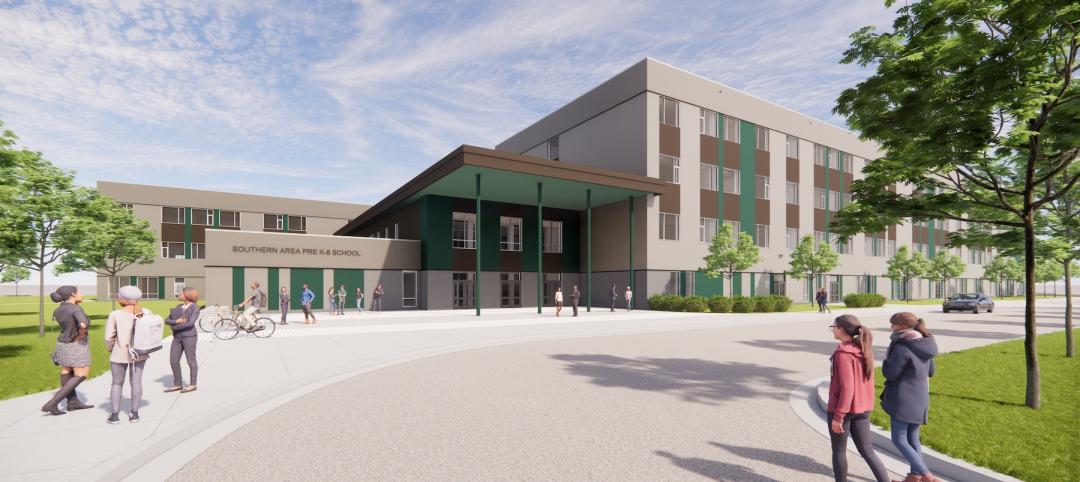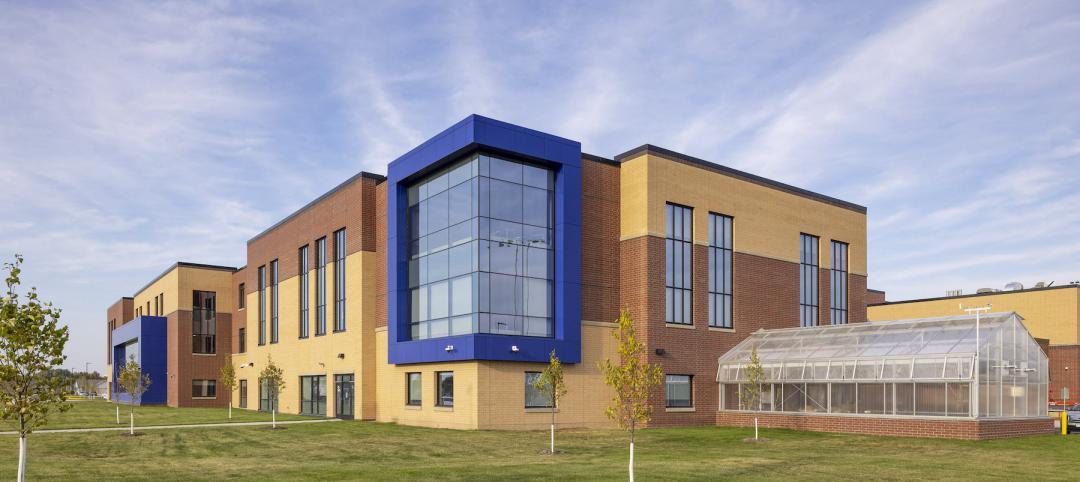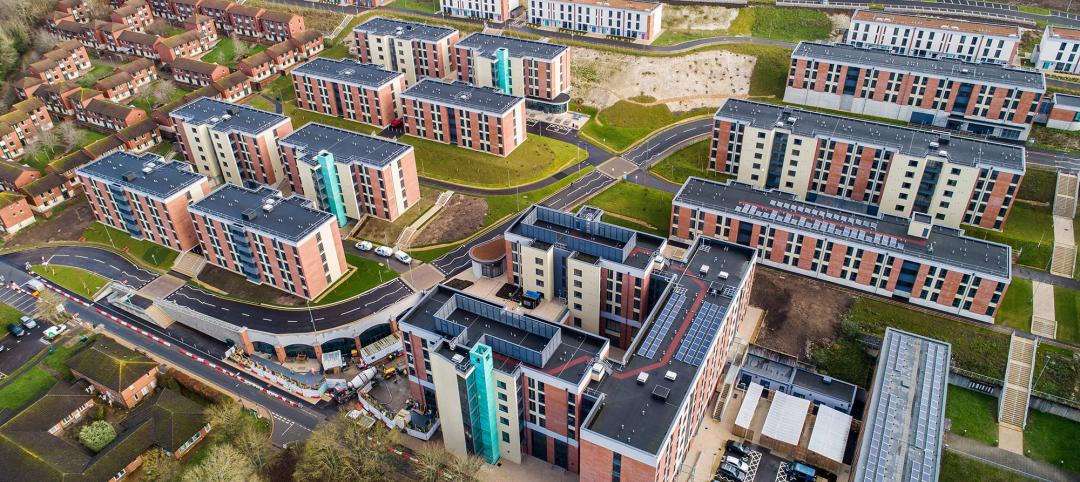Shouldn’t major financial investments in new schools benefit both the students and the greater community? Conventional wisdom says yes, of course. That logic explains the growing interest in joint-use schools—innovative facilities designed with shared spaces that address the education needs of students and the community’s need for social, recreation, and civic spaces.
Three such joint-use schools—Hector Godinez High School in Santa Ana, Calif.; GlenOak High School in Canton, Ohio; and Hubble Middle School in Wheaton, Ill.—are prime examples of how innovative Building Teams are serving both students and the general public through community partnerships, shared land usage, and clever financing schemes to create facilities that function not just as schools, but also as vibrant community centers.
Hector Godinez High School, Santa Ana, Calif.
“This campus is a model for shared facilities where dedicated space is an issue,” says Rick D’Amato, AIA, LEED AP, project design principal at LPA, the Irvine, Calif.-based architecture firm in charge of the $66 million Hector Godinez High School project.
The Santa Ana Unified School District owned a scant 5.5 acres for the project, hardly enough room for the comprehensive 2,500-student high school the district hoped to build. Fortunately, the site was surrounded by generous amounts of open space, including 20.5 undeveloped acres within Santa Ana’s Centennial Regional Park. Another chunk of land belonged to the Discovery Museum of Orange County (now known as Centennial Heritage Museum).
Even at 26 acres, though, the site was 15-20 acres short of the typical site requirements for a school this size, according to D’Amato, especially since the school district also wanted to put a multiuse performing arts center, athletic facilities, hard courts, and several playing fields on the site. Despite the site limitations, the district was adamant about building in this location because school services in the area were badly needed. Even though Santa Ana is within what is arguably the most affluent county in the nation, it serves a much more economically depressed population than you’ll see on “The Real Housewives of Orange County.”
So the Building Team went to work to hammer out a deal with the city and the museum to get enough land to build the project the right way.
As it happened, all the players had something to gain from working together.
From the city’s perspective, the portion of Centennial Regional Park that would be used by the Hector Godinez campus was a no-man’s land, according to D’Amato. “The city saw this as a way to complete the park, and as a way to pump up community services in this particular area,” he says.
As for the Discovery Museum of Orange County, it would gain access to new research space, art and science labs, and an amphitheater. Based on LPA’s design, the school buildings would create a new buffer against several industrial buildings near the museum grounds.
The district, in turn, would get the 20.5 acres from the city at no cost. “Everyone had something to gain, and it was easier to get this project built because it was something everyone really needed and could use,” says D’Amato.
Since its completion in 2006, everyone has really been using the school. Almost every facility is available to the community: the cross-court gymnasium; the performing arts complex, with its 450-seat auditorium, workshop, and black box theater; flex spaces that serve as tutoring, adult education, and community meeting rooms; two distinct outdoor spaces; a main street and a plaza; and a 514-car parking garage (the tight site didn’t allow for paved parking).
Joint-use spaces account for about 60,000 of the school’s total 260,000 sf. Ironically, the school library is for use only by students, but that’s because the community already had a public library.
To create a high school that serves both students and the community, the Building Team relied on a Main Street-type concept. The designers created an outdoor pedestrian plaza that can be closed off on either end to control student circulation during the day and community traffic in the evenings and weekends. Many of the school’s joint-use facilities, including the performing arts complex and athletic facilities, front the main street on the north side, while dedicated student buildings front it on the south side and create a gateway to the school’s second major outdoor space, the zócalo (Spanish for “central town square” or plaza). The zócalo meanders through the campus, connecting all educational and administrative spaces, as well as the amphitheater and the joint-use science and art facilities.
“The zócalo is the active heart of the facility,” says D’Amato. During the day, it becomes the hub of student activity, with food carts and kiosks to serve their daily needs. On weekends the community uses the space for farmers’ and open-air markets.
GlenOak High School, Canton, Ohio
“The message we wanted to send was, This is a learning center for the entire community,” says Jackie DeGarmo, former superintendent of the Plain Local School District in Canton, Ohio, and now president of local consulting firm Hilliard Jeane. DeGarmo says that if she had had her druthers, the 2,300-student, 371,000-sf GlenOak High School would not even have been called a school, but rather a community center. “We thought, we cannot design this facility believing that the only people using it would be teenagers arriving on big yellow buses,” she says.
That message was communicated to Steven Turckes, AIA, REFP, LEED AP, principal in the Chicago office of Perkins+Will, the architecture firm responsible for the high school, along with local firm Balog Steines Hendricks & Manchester Architects.
“We knew one of the big goals was intense community partnerships,” says Turckes. “In conversations with [DeGarmo] about the school, she said it should have a different look and feel from a traditional high school because it wasn’t going to be a traditional school.”
And a traditional high school it’s not. In addition to the modern education spaces required of a new 9-12 facility—four wings supporting six specialized career academies—the joint-use campus includes a 20,000-sf public library branch; a professional-grade, 900-seat performing arts center; an athletic center; a privately operated cyber café; three art studios; an outdoor piazza; flex space with rooms for community meetings, continuing education, etc.; and an outdoor interpretive laboratory. Coming soon: an in-school community health center, possibly evolving into a stand-alone, on-campus facility (in partnership with local healthcare provider Mercy Medical) and a possible partnership with a local college to establish on-campus continuing education classes.
“The process we went through to program the building was very participatory and involved numerous community partners,” says Turckes. A group of about 65 people spent almost a year compiling a wish list of services and features. Then DeGarmo went to work rallying community support for a $65 million bond referendum to build the school.
“We have a history of not passing school bonds,” she says. About 82% of district households do not have children enrolled in the public schools, so DeGarmo stressed the community services in the project, including a public library, which otherwise would not be built. On top of that, the Canton area has faced severe economic hardship with the closing of plants by Goodyear, B.F. Goodrich, and Hoover.
By emphasizing the increased services that would be available through joint use, DeGarmo was able to piece together support and funds for the project. The KnowledgeWorks Foundation provided invaluable support, training, and a consultant. The Plain Local Schools Foundation contributed $397,000 to the performing arts center, making it possible to expand the facility from 600 seats to 900, and to add balcony seating, a full fly loft, a black box theater, and upgraded finishes and equipment.
The Plain Stark County District Library came up with $1.5 million over a 20-year lease for the library space, which nearly doubled in size, from 12,000 sf to 20,000 sf. “The library was quite a battle for us,” says DeGarmo. “It wasn’t just moving a public library into our building; it was eliminating a school library and putting in an actual public library branch.” The two-story space is programmed so the public enters on the ground floor while students enter on the second floor. “This library has really helped the school become the center of the community,” says DeGarmo.
Located next to the library is a cyber café, which is independently leased and operated. The café opens to a large brick piazza that also serves as the public’s entrance to all joint-use spaces, including three loft-like art studios. Art fairs are also held there in the good weather. Although the café is open to both the public and students, DeGarmo says the target customers are seniors whose previous social hub was a local McDonald’s. Future plans call for students to operate the café as part of the school’s business curriculum.
Aesthetically, the Building Team drew on the area’s industrial heritage and incorporated such materials as brick, metal, and glass into the project, while endeavoring to give the building a stylish edge. “We wanted this facility to be something attractive to adults,” says DeGarmo. “We didn’t want it to look like a place where only teens hang out.” She also points out that, as future partnerships with colleges or universities materialize, “We didn’t want college-age or adult students to feel as if they were coming to their local high school to earn an important degree.”
Hubble Middle School, Wheaton, Ill.
“The community was used to having access to the school, so when it was relocated out of downtown, there was the expectation that they would have access to space they always had,” says Patrick Brosnan, AIA, LEED AP, in reference to the Wheaton/Warrenville community’s use of the new Hubble Middle School in suburban Chicago.
Brosnan is president and CEO of Legat Architects, Oak Brook, Ill., the architecture firm tasked with making the 1,078-student middle school exceed the community’s expectations when it opens in summer 2009.
The new $58 million Hubble Middle School replaces an outdated 1920s facility that sat in the heart of Wheaton’s historic downtown. Not only had the old school fallen well below district standards, but at 253,000 sf, it was a huge white elephant. Right-sizing the new facility and maximizing its energy efficiency, while providing all the joint-use space the community expected, were paramount requirements for the project.
Eliminating unnecessary square footage and utilizing a modern infrastructure greatly increased the new school’s efficiency, but Brosnan also stepped it up a notch by introducing significant green features, setting Hubble Middle School on the path to LEED Silver, possibly Gold.
The right-sizing process indicated that the new school required about 191,000 sf, almost half of which (91,040 sf) is joint-use space. The community has access to a 500-seat auditorium, two gymnasiums, a fitness center (shared with the park district), a library, an art room with flex space, and a cafeteria. “We couldn’t ignore the needs of the community,” says Brosnan. “Their input during the programming discussion was very important.”
The school’s zoned layout accommodates both student and community use, and allows the school flexibility in controlling access to various areas. “The school is laid out so all shared areas are almost in a separate building,” says Brosnan. One main hallway is used to access the auditorium, the two gymnasiums, the fitness center, and the cafeteria, which occupy a single-story wing. A two-story glass bridge, which houses the art/flex room on the first floor and the library on the second, connects the joint-use wing to the three-story education/student wing, where classroom arrangements support team teaching.
Because this is a middle school (grades 6-8), some joint-use features could be scaled back. The auditorium doesn’t have a fly loft and is finished in school-grade materials. “A middle school wouldn’t need these features, even with the community also using the auditorium,” says Brosnan. In any case, the local high school has a high-end performing arts facility. There’s no quarter-mile running track, either; instead, the school will partner with the park district to use existing pathways running through the 18-acre site.
Other community partnerships involve the school’s “borrowing” neighboring property for stormwater detention, obviating the need for the school district to purchase an additional five acres. The school also borrows parking from an office complex next door. Figuring out the parking was tricky: on the one hand, Brosnan needed to provide enough space to support community use of the school; at the same time, middle school students don’t drive, so only a small number of cars would be using the lot. Getting use of the neighbor’s lot for overflow parking allowed Hubble Middle School to achieve a 20% reduction in pavement. “The last thing you want to do when designing a sustainable school is put in pavement that might be used only 10 times a year,” says Brosnan.
The school’s energy needs will be reduced through the use of natural daylighting (augmented by automated lighting controls), a cool roof, a separate vegetated roof (connected to the library, and accessible to both students and the community), permeable pavement, drought-resistant landscaping, bioswales, rapidly renewable materials, and the diversion of 50-75% of construction waste from landfills. Brosnan also points out that the old school’s 22-acre site in downtown Wheaton is now available, providing an excellent redevelopment opportunity for new housing, retail, and service businesses.
|
Related Stories
Education Facilities | Nov 9, 2023
Oakland schools’ central kitchen cooks up lessons along with 30,000 meals daily
CAW Architects recently completed a facility for the Oakland, Calif., school district that feeds students and teaches them how to grow, harvest, and cook produce grown onsite. The production kitchen at the Unified School District Central Kitchen, Instructional Farm, and Education Center, (“The Center”) prepares and distributes about 30,000 meals a day for district schools lacking their own kitchens.
Products and Materials | Oct 31, 2023
Top building products for October 2023
BD+C Editors break down 15 of the top building products this month, from structural round timber to air handling units.
Giants 400 | Oct 30, 2023
Top 170 K-12 School Architecture Firms for 2023
PBK Architects, Huckabee, DLR Group, VLK Architects, and Stantec top BD+C's ranking of the nation's largest K-12 school building architecture and architecture/engineering (AE) firms for 2023, as reported in Building Design+Construction's 2023 Giants 400 Report.
Giants 400 | Oct 30, 2023
Top 100 K-12 School Construction Firms for 2023
CORE Construction, Gilbane, Balfour Beatty, Skanska USA, and Adolfson & Peterson top BD+C's ranking of the nation's largest K-12 school building contractors and construction management (CM) firms for 2023, as reported in Building Design+Construction's 2023 Giants 400 Report.
Giants 400 | Oct 30, 2023
Top 80 K-12 School Engineering Firms for 2023
AECOM, CMTA, Jacobs, WSP, and IMEG head BD+C's ranking of the nation's largest K-12 school building engineering and engineering/architecture (EA) firms for 2023, as reported in Building Design+Construction's 2023 Giants 400 Report.
K-12 Schools | Oct 21, 2023
The Blueprint Schools Program in Maryland reins in construction time and cost
This collaborative P3 is also committed to expanding participation of small and minority businesses.
K-12 Schools | Oct 4, 2023
New high school in Minnesota provides career pathways for students
This 90-acre school campus also features myriad sports facilities.
K-12 Schools | Oct 2, 2023
4 design strategies for successful K-12 magnet schools
Clark Nexsen's Donna Francis, AIA, Principal, and Becky Brady, AIA, share four reasons why diverse K-12 magnet schools require diverse design.
Contractors | Sep 25, 2023
Balfour Beatty expands its operations in Tampa Bay, Fla.
Balfour Beatty is expanding its leading construction operations into the Tampa Bay area offering specialized and expert services to deliver premier projects along Florida’s Gulf Coast.
K-12 Schools | Sep 5, 2023
CHPS launches program to develop best practices for K-12 school modernizations
The non-profit Collaborative for High Performance Schools (CHPS) recently launched an effort to develop industry-backed best practices for school modernization projects. The Minor Renovations Program aims to fill a void of guiding criteria for school districts to use to ensure improvements meet a high-performance threshold.
















